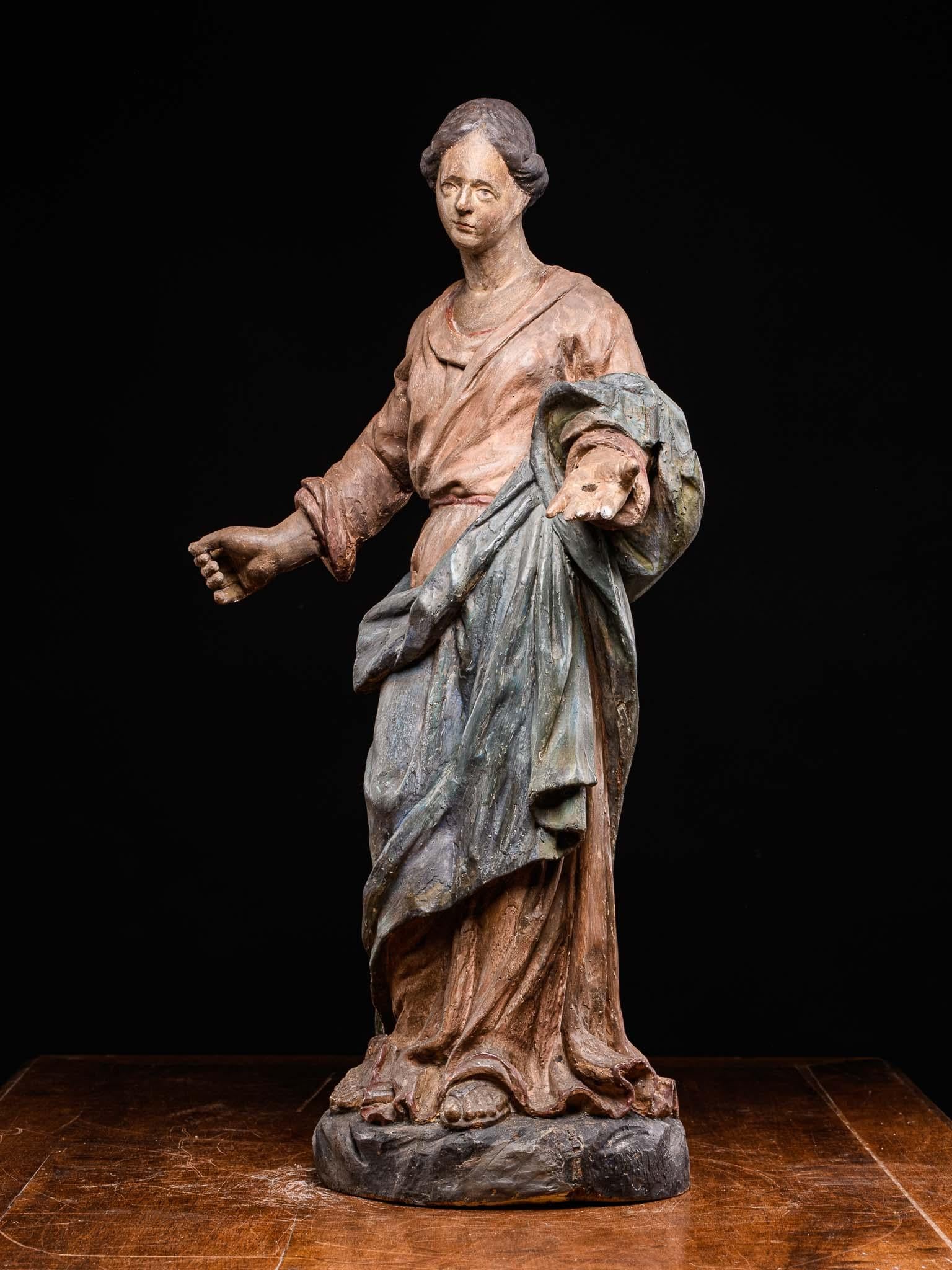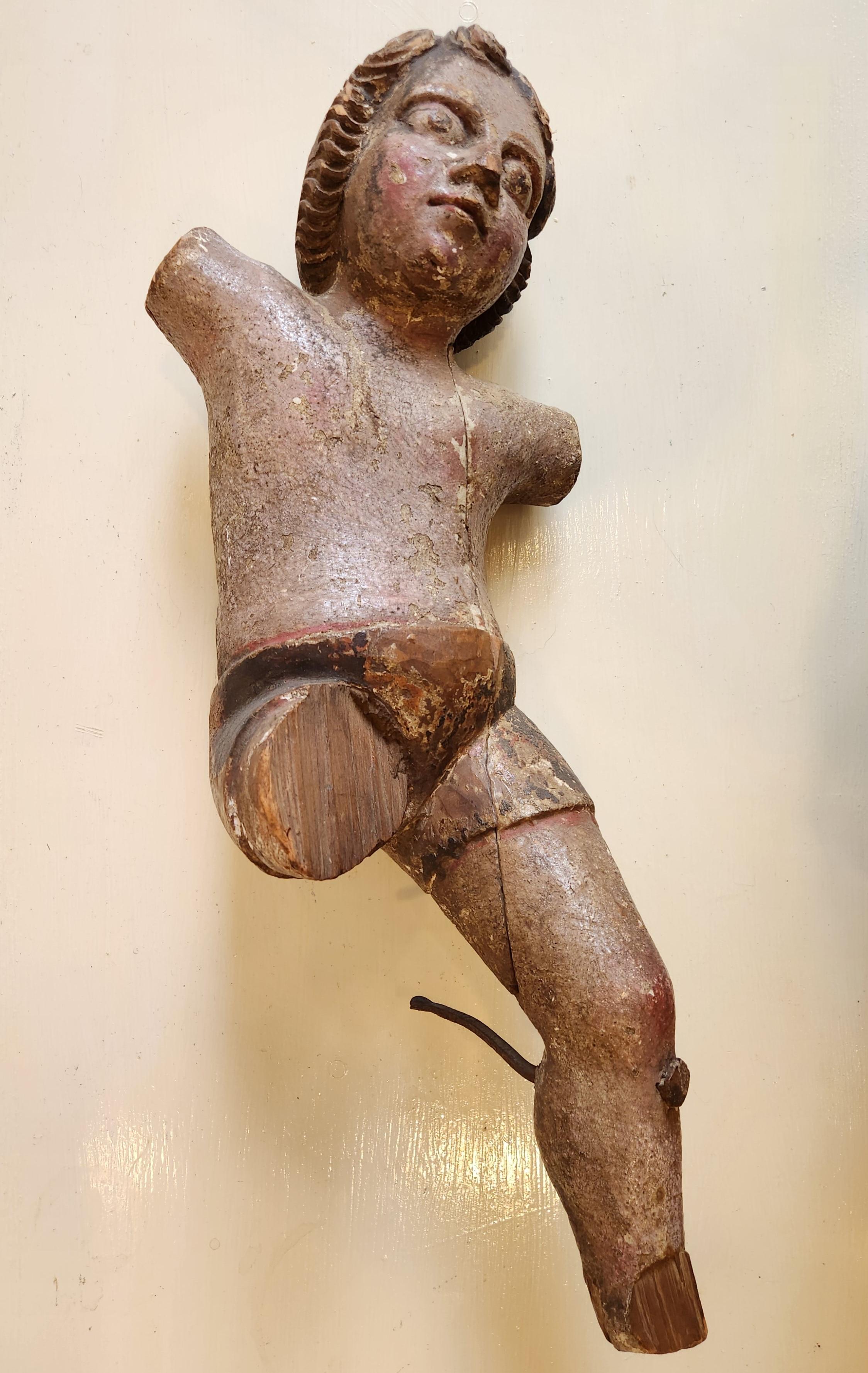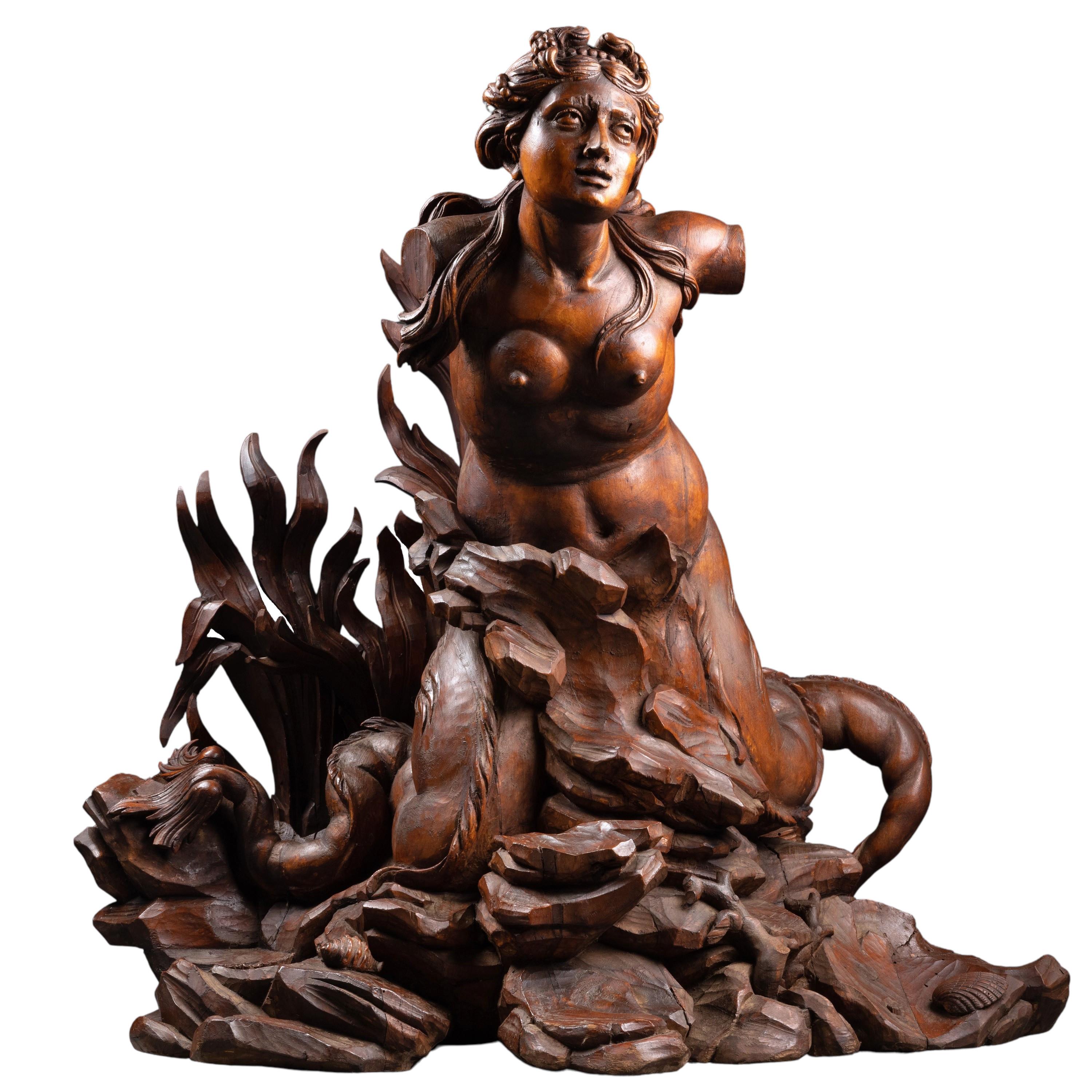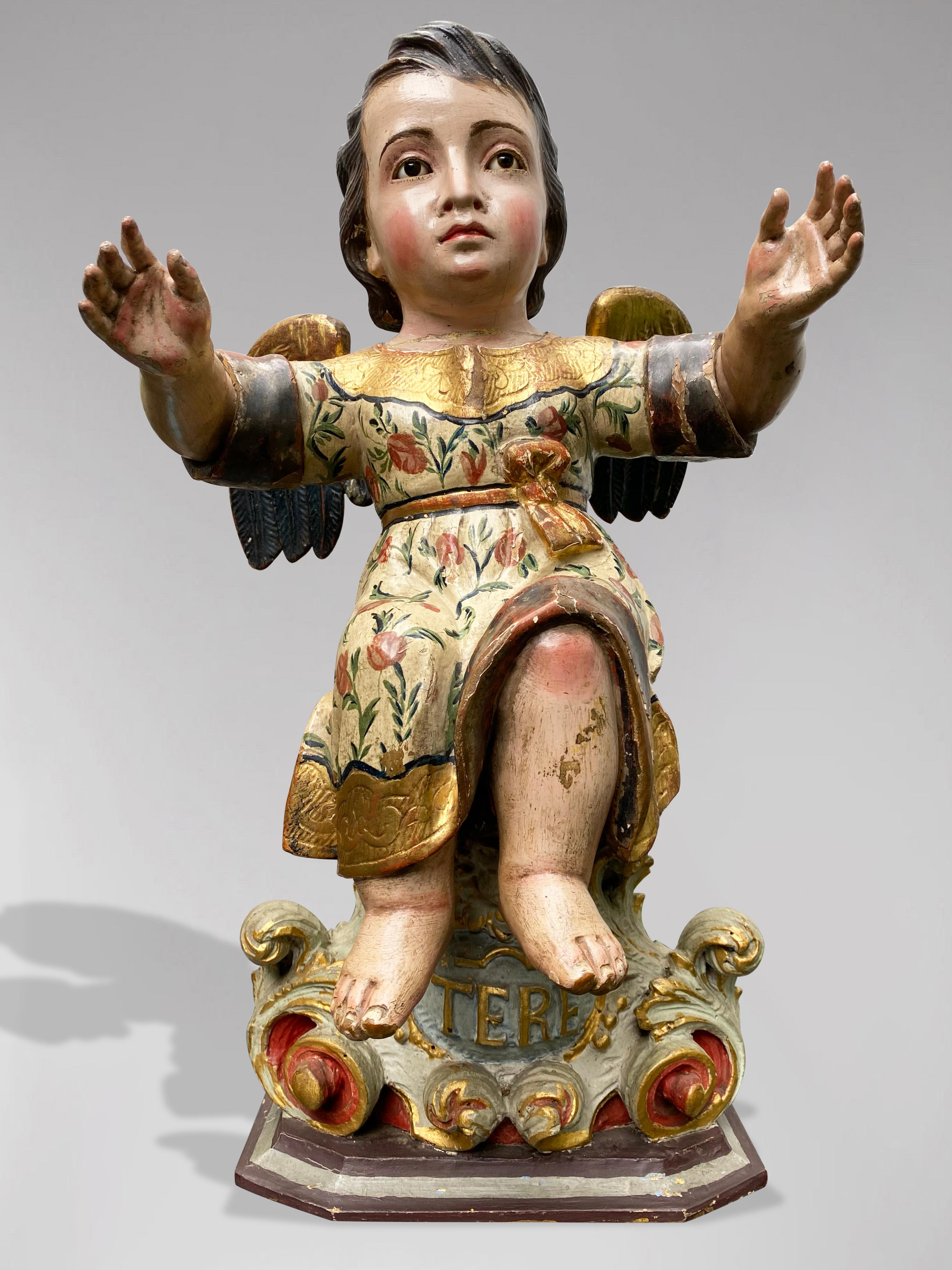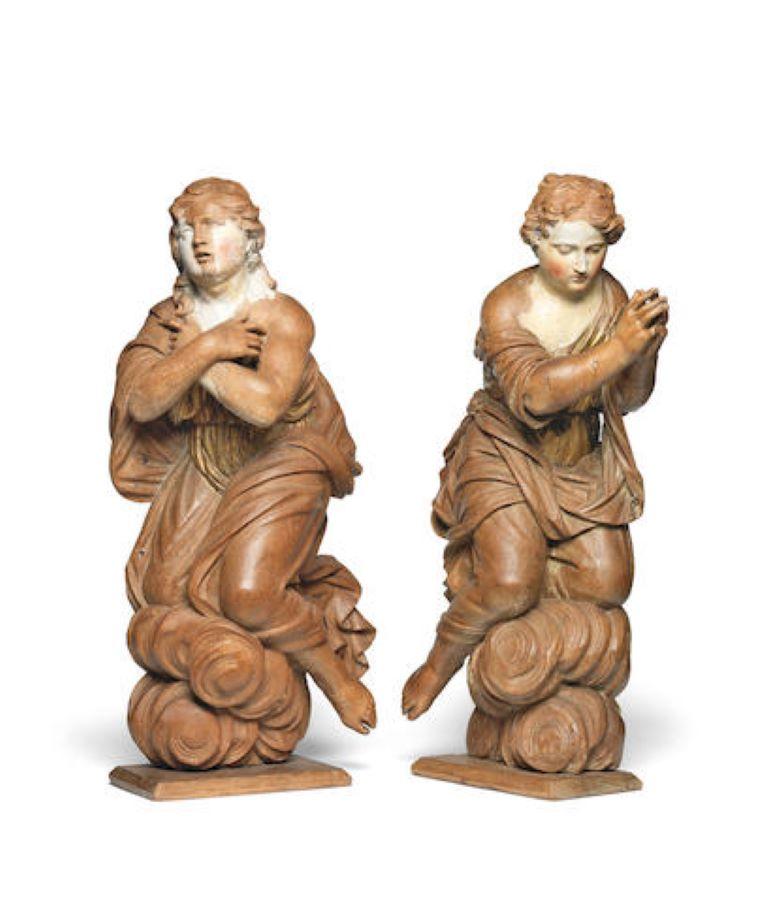Items Similar to Late 17th C, Baroque, Saint, Italian School, Wooden Sculpture of Saint Anthony
Want more images or videos?
Request additional images or videos from the seller
1 of 19
UnknownLate 17th C, Baroque, Saint, Italian School, Wooden Sculpture of Saint AnthonyUnknown
Unknown
About the Item
The impressive life-size statue of St. Anthony (Lisbon, 1195 – Padua, 1231) used to be probably in a church or monastery of the mendicant order of the Franciscans. You can immediately recognize a Franciscan monk by his brown habit, brown hooded cloak and the cord with knots around his waist. The cord does not only serve a utility function to keep the habit together. Each of the three knots in the rope symbolizes a monastic vow: chastity, obedience and poverty. The vow of poverty is also the reason why the Franciscans live barefoot. The depiction of the saint with the Christ child on his arm goes back to a miracle.
When Anthony was meditating over a book about Christ’s cross, suddenly the child appeared above his manuscript. The play of the saint’s resting and supporting leg provides a bit of liveliness. The movement of the cloak hanging over the arm and the deep-hanging folds of the robe make the sculpture look elegant. The exchange of glances between Anthony and the Christ child creates a quiet intimacy. At the back of the statue, a small iron bar has been attached to anchor the sculpture in the wall. The smoothly polished surface of the wood ensures an excellent glide of light on the material.
- Creation Year:Unknown
- Dimensions:Height: 57.09 in (145 cm)Width: 27.96 in (71 cm)Depth: 15.75 in (40 cm)
- Medium:
- Movement & Style:
- Period:
- Condition:
- Gallery Location:brussel, BE
- Reference Number:
About the Seller
5.0
Vetted Seller
These experienced sellers undergo a comprehensive evaluation by our team of in-house experts.
1stDibs seller since 2021
14 sales on 1stDibs
- ShippingRetrieving quote...Ships From: brussel, Belgium
- Return PolicyA return for this item may be initiated within 3 days of delivery.
More From This SellerView All
- 17th C Polychromed fruitwood carved statue depicting Madonna, France.Located in brussel, BEAn exceptionally beautiful antique French wood carving, made in the 17th century. It depicts Madonna standing with open offering arms .The...Category
17th Century Baroque Figurative Sculptures
MaterialsWood
- 17th C Stone statue of Saint Erasmus or Saint ElmoLocated in brussel, BESaint Erasmus or Saint Elmo (Antioch, ca. 240 – Formia, 303) was an Italian bishop and patron saint of the sailors. His attribute was the capstan, a winch on which the anchor chains were rolled up. He died as a martyr for his faith, and his bones were transferred to Gaeta in the 9th century, where they are kept in the cathedral to this day. The electric phenomenon of Saint Elmus fire is named after Saint Erasmus and the 16th C humanist Desiderius Erasmus. Little is known with certainty about Saint Erasmus' life. However, many legends may have been passed on orally until - no older writings are known with certainty. His birthplace was in present-day Syria. However, the persecution of Christians under Emperor Diocletian forced him to flee to Mount Lebanon...Category
17th Century Baroque Figurative Sculptures
MaterialsStone
- Pair of 19th C Carousel Decorative Female Torsos attributed to Charles I.D. LuffLocated in brussel, BEThis pair of female torsos presumably decorated a fair stand or an organ in a theme park. They were most likely part of a significant organ intended to ente...Category
19th Century Figurative Sculptures
MaterialsWood
- Standing Human Skeleton in Wood, South East AsiaLocated in brussel, BEThe highly expressive wooden skeleton was carved and polychromed in the early 20th century in Burma, today's Myanmar. Unlike many sculptures from that region, his one is not directly...Category
20th Century Other Art Style Figurative Sculptures
MaterialsWood
- 18th C Polychromed fruitwood carved statue depicting Maria Magdalena, Germany.Located in brussel, BEThis beautiful polychrome and highly expressive statue 18th C statue represents Mary Magdalene in prayer, hands joined, eyes raised to the sky.It's of German originCategory
18th Century Other Art Style Figurative Sculptures
MaterialsWood
- 19th C Pair of Breton polychromed fruitwood statues depicting FishermansLocated in brussel, BE19th C Pair of Breton polychromed fruitwood statues depicting Fisherman and his wife .Origin France.Category
19th Century Folk Art More Art
MaterialsWood
You May Also Like
- Tuscan Baroque Nude Putto Candle Holder 17-18 century gilded woodLocated in Florence, ITOne flame candle holder putto made of gilded wood. Those kind of objects were present in churches or noble villas, specially during the Baroque times. The base is not coeval.Category
17th Century Baroque Nude Sculptures
MaterialsGold
- Polychrome Carved Mexican Sculpture -- Child JesusLocated in Troy, NYThis is a hand-carved wood polychromed sculpture of the Infant Jesus. A baroque figure probably from the 18th century, this religious figure was obtained in Mexico. It appears to hav...Category
18th Century Baroque Figurative Sculptures
MaterialsWood, Paint
- A late 17th Italian carved limewood figure of Mermaid, circle of Filippo ParodiLocated in PARIS, FRA late 17th c. Italian carved figure of Mermaid, Circle of Filippo Parodi (Genoa, 1630 – July 22, 1702) Dimensions: h. 29.13 in, w. 30.31 in, p. 18.9 in (at the base) Magnificent Italian Baroque sculpture depicting a mermaid seated on the rock. All the virtuosity of the sculptor unfolds in this carved group. The fantastic creature is featured seated, the upper part of the body darting forward, the head looking upwards. Sophisticated hairstyle with rows of pearls intertwined in her hair, her loose locks fly in the wind and bring movement to the whole sculpture. The wide-open eyes with hollowed-out pupils make it possible to follow the mermaid's gaze, towards the sky. The half-open mouth further magnifies this bewitching and seductive attitude. Its long double tail ending in fins wraps on either side of a rocky mound strewn with objects evoking the underwater world: seashells and shells, branches of coral. The ornamental richness combined with the great care taken in its execution make it a work in which the splendor of Italian Baroque art unfolds in such characteristic scenic movement. The composition betrays a strong influence from Filippo Parodi, the leader of Genoese Baroque sculpture, and points to an artist from his circle. Our sculpture was probably part of a decorative monumental palace. The iconographic theme evoking the marine world finds its application in the numerous fountains and artificial grottos, designed in Italian palaces at the turn of the 17th and 18th centuries. Giacomo Filippo Parodi (Genoa 1630 – July 22, 1702) was an Italian Baroque sculptor of the Genoese school, who introduced Bernini's aesthetic to Genoa. In his youth fathers a first apprenticeship with a carpenter, he went to Rome where he became a pupil of Bernini. He had the opportunity to admire in person the works and style of the French sculptor Pierre Puget...Category
Late 17th Century Baroque Figurative Sculptures
MaterialsWood
- A Spanish Statue of a Sitting on a Pedestal Angel with Open Arms, Early 19th CLocated in Bruges, BEDescription: A Spanish Statue of a Sitting on a Pedestal Angel with Open Arms in polychromed wood, Early 19th Century Statue: Statue of an Angel Object Type: Statuette Artist, Sculp...Category
Early 19th Century Baroque Figurative Sculptures
MaterialsWood
- A pair of late 17th century Northern European carved oak angelsLocated in Bath, SomersetA pair of carved oak angels, circa 1700, with a lovely warm patina and faint traces of polychrome to the face and gilding to the body. The angels are both kn...Category
17th Century Baroque Figurative Sculptures
MaterialsOak
- Pedestal Console Sculpture Baroque Putto Gilded Wood Italy 18th centuryLocated in Pistoia, ITImposing Baroque solid wood carved and gilded altar pedestal or base, Italy, Tuscany, early 18th century. The base is richly carved on three sides in the shape of a cloud from which...Category
Early 18th Century Baroque Figurative Sculptures
MaterialsWood
Recently Viewed
View AllMore Ways To Browse
Wooden Art Italian
Italian Baroque Art
Small Wooden Art
Small Antique Sculpture
Antique Wooden Sculpture
Antique Wooden Sculptures
Wooden Figurative Sculpture
Church Sculpture
Small Antique Iron
Antique Small Iron
Arm Sculpture
Italian Life Size Sculpture
Antique Wood Saint
The Antique Exchange
Wooden Light Sculptures
Baroque Material Used
Rober Browning
Antique Saints Sculptures
